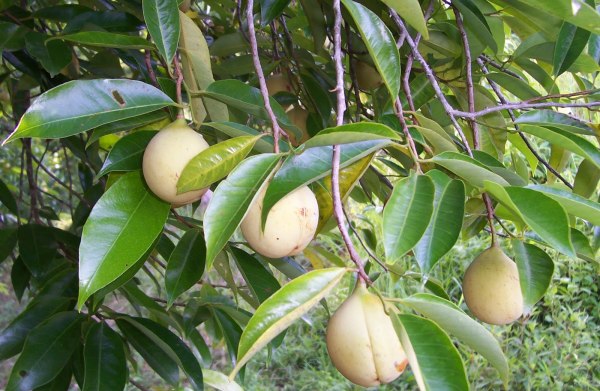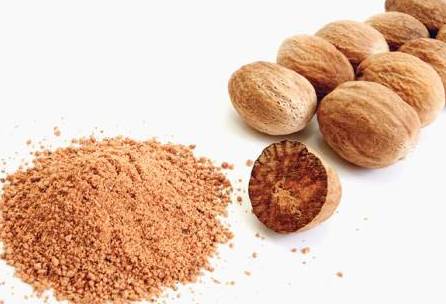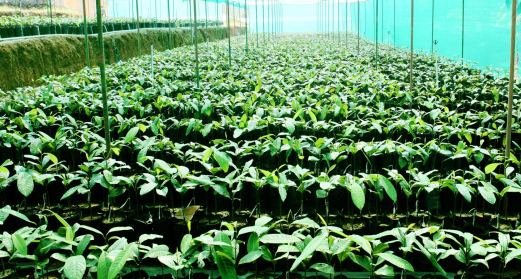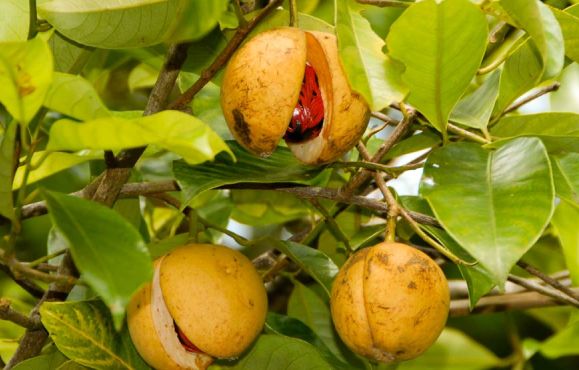Nutmeg Cultivation Guide:
Introduction of Nutmeg Cultivation:- What is Nutmeg? Well, Nutmeg is an evergreen perennial tree that reaches about 10 meter height and produces two different spices. Nutmeg and mace are the output of this tree. Nutmeg is actually a dried kernel of the seed where as mace is dried aril surroundings of the seeds (Nutmeg is the shelled, dried seed of the plant Myristica fragrans, and mace is the dried net-like covering of the shell of the seed). Nutmeg tree belongs to the family of “Myristicaceae” and genus of “Myristica”. Nutmeg & mace are used to make medicine. Nutmeg and mace are used for diarrhea, nausea, stomach spasms and pain, and intestinal gas.

Nutmeg used as condiment in sweet foods. Dutch dishes use the seasonings in ground form. Nutmeg oleoresin used in preparation of meat products, soups, sauces, baked foods, puddings etc. Nutmeg oil is used in cosmetics and toiletries.
Health Benefits of Nutmeg:- The following are some of the health benefits of Nutmeg.

- Nutmeg aids in pain relief.
- Nutmeg is good for digestion.
- Nutmeg is good for people who have Alzheimer’s disease.
- Nutmeg is good for brain function.
- Nutmeg is helpful in Insomnia patients.
- Nutmeg is good for oral health.
- Nutmeg helps leukemia patients.
- Nutmeg helps to lower the blood pressure.
- Nutmeg helps in maintain the bone health.
- Nutmeg helps to dissolve kidney stones.
- Nutmeg helps in elimination of toxins from the body.
- Nutmeg helps in reduce inflammation and irritation of skin.
- Nutritional values in Nutmeg: Vital B-complex vitamins including vitamin C, folic acid, riboflavin, niacin, vitamin A and anti-oxidants which are essential for optimum health.
Main Production States of Nutmeg in India:- The main Nutmeg growing states in India are Kerala, Tamil Nadu and Karnataka.
Local Names of Nutmeg in India:- Nutmeg (English), Jaiphal (Hindi), Jaadhikai (Tamil), Jajikayi (Telugu), Jaiphal (Bengali), Jayiphal (Gujarati), Jaiphal (Konkani), Jayphal (Marathi), Jaiphala (Oriya),Jaiphal(Punjabi, Urdu) and Zaaphal (Kashmiri).
Varieties of Nutmeg:- There are improved varieties of Nutmeg in India. However, there are ten Nutmeg accessions with high yielding have been identified. One line and A9/4 are in the pre-release stage. Another variety available in india is IISR-Viswashree.
Climate and Soil Requirement for Nutmeg Cultivation:- Nutmeg crop grows well in humid and warm climatic conditions. This crop requires an annual rainfall of 150 cm above. These trees grow up to 1000 meters above msl (mean sea level). The best suited soils for Nutmeg cultivation are sandy loam, clay loam and red laterite. Draught and water stagnation conditions are not suitable for Nutmeg farming. Nutmeg grows best with a pH level of 6.0 to 7.0
Propagation in Nutmeg Cultivation:- Propagation is mainly done by seeds. As Nutmeg trees are perennial and dioeciously in nature, an alternative method of propagation is in progress. Epicotyls grafting, patch budding and approach grafting are most successful in Nutmeg propagation.
Land Preparation, Spacing and Planting in Nutmeg Cultivation:- Land should be ploughed thoroughly till it attains fine tilth stage and to destroy any weeds from previous crops.
When it comes to nursery raising seedlings, naturally split and healthy fruits should be harvested during the June & July months. The seeds should be extracted from the pericarp and sown immediately in sand beds of 1.5 meter width and 15 cm height. Make sure to provide regular watering for better and quick germination. Usually, the germination of nutmeg seeds start from 1 month to 3 months after sowing. An about of 3 weeks old sprouts should be moved to polythene bags that contain mixture of good soil, sand and well decomposed farm yard manure in 3:3:1 ratio. Once the seedlings attain 18 to 24 months, they can be transplanted to main field.

The planting in the main field should be done at the onset of monsoon/rainy season. Dig the pits of 0.75 meter x 0.75 meter and these pits should be filled with organic manure and good soil 2 weeks earlier to actual planting. The spacing varies widely and spacing of 7 meter to 8 meter appears to be sufficient. In case of grafting, 5 meter x 5 meter should be optimum.
It is recommended to protect the nutmeg plants from sun scorch by providing the shade in the early stage. Permanent shade trees should be planted when the site is on hilly slope and when this crop is grown as mono-crop.
Manures and Fertilizers in Nutmeg Cultivation:- Usually, Organic manures should be applied in Nutmeg plantation. Bone-meal is popular among the growers. Generally, manures should be applied in shallow trenches or pits dug around the trees. However, a dose of 20 grams of ‘N’ (45 grams urea), 20 grams of P2O5 (110 grams of superphospahte) and 50 grams of K2O (80 grams of muriate potash) should be applied during initial year and 500 grams ‘N’ (1100 grams of urea), 250 grams P2O5 (1,550 grams superphosphate) and 100 grams of K2O (1650 grams muriate of potash) per year should be applied in subsequent years for fully grown trees of 15 year or more.
Irrigation in Nutmeg Cultivation:– Generally, Nutmeg plants require good irrigation for high yield and quality of fruits. However, the frequency of irrigation depends on the season, moisture holding capacity of the soil and plant age. Usually, in dry and summer seasons, it requires frequent irrigation.
Intercropping in Nutmeg Cultivation:– During initial stage of plantation, any low growing vegetable crops and be cultivated as intercrops in Nutmeg cultivation. Nutmeg can be best grown as an intercrop in old coconut orchards, clove, areca-nut and coffee gardens, where light shade conditions are suitable.
Intercultural operations in Nutmeg Cultivation:– During initial years, regular mulching of plant basins should be carried out after slashing weeds and shading in summers. Banana trees can be grown for shading purpose in the early stage of Nutmeg plantation.
Pests and Diseases in Nutmeg Cultivation:– The hard scale Saissetia nigra occurs on the pencil thick branches & desaps the tissues. The infested shoots invariably develop sooty mould cover. It can be controlled by spot spraying with quinalphos 0.025%.
- Leaf spot and shot hole: Sunken spots surrounded by a yellow halo are the initial symptoms. Subsequently the central portion of the necrotic region drops off resulting in shot hole symptoms. Dieback symptoms are also observed in some of the mature branches. On young seedlings drying of the leaves and subsequent defoliation are seen. The disease can be controlled by spraying 1% Bordeaux mixture two or three times during rainy season.
- Fruit rot: This is caused by Colletotrichum gloeosporioides and Botryodiplodia theobromae. Water soaked lesions are seen on the fruits, the tissues of which become discolored and disintegrated. Premature splitting of the pericarp and rotting of mace and seed are the main symptoms of the disease. The internal tissues are found rotten. The fallen fruits become enveloped with the growth of the organism. The disease can be controlled by spraying 1% Bordeaux mixture.
The other diseases include leaf blight, leaf spot, sooty mould and the algal leaf spot.
Harvesting and Post-Harvesting in Nutmeg Cultivation:- Generally a female nutmeg tree starts fruiting from the 6th year and the peak harvesting period reaches after 20 years. The nutmeg fruits will be ready for harvesting 9 months after flowering. In Nutmeg farming, flowering and harvesting continues throughout the year. The nutmeg fruits ripen and become ready for harvesting when their pericarp splits open. Harvesting should be done by bill hook. The outer fleshy portion should be removed and the mace should manually be separated from the nut. The nuts and mace should be dried separately for 3 to 5 days.

Yield in Nutmeg Cultivation:- Generally, yield of the crop depends on the soil, weather conditions, farm management practices. In nutmeg cultivation, at 8th year, 480 kg mace/ha and 3122 kg nuts/ha can be obtained. The yield will increase in subsequent years, a potential yield of 4,800 kg mace/ha and 31,000 kg nuts/ha can be obtained from 25 years old trees.
For Sheep Farming Guide: Read here.
For Asia Farming Guide: Read here.
How I can download or copy this report.
We don’t have a download option at this point in time.
Hi, can you please share me with your name, contact number and location. We are looking for 200 plants. Would like to talk in detail.
Please can you share your contact…we are looking 100 seeds for planting.